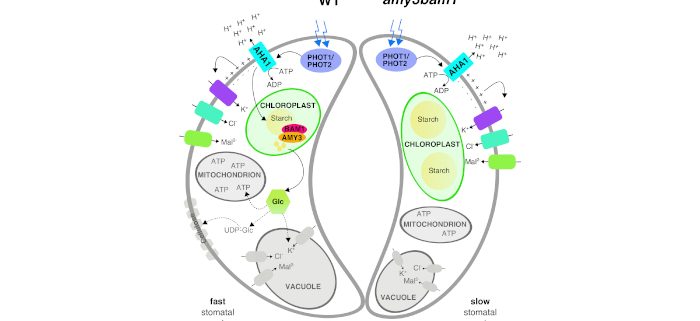Guard cell starch-derived glucose drives fast stomatal opening kinetics
Flütsch et al. examine how starch degradation and light-regulated membrane transport control stomatal opening kinetics.
Plant Cell https://doi.org/10.1105/tpc.18.00802
By Sabrina Flütsch and Diana Santelia
Institute of Integrative Biology, ETH Zürich, Zürich, Switzerland
Background: Stomatal opening is driven by the blue light-activated H+-ATPase (AHA1) at the guard cell plasma membrane, which hyperpolarizes the plasma membrane causing the intake of potassium (K+), chloride (Cl–), malate (Mal2-) and nitrate (NO3–), resulting in increased cell turgor and stomatal aperture. In parallel to the activation of membrane ion transport, guard cell starch is rapidly degraded upon illumination after dawn through the coordinated activity of the glucan hydrolases a-amylase 3 (AMY3) and b-amylase 1 (BAM1) to promote stomatal opening. Plants simultaneously lacking BAM1 and AMY3 open their stomata more slowly and to a lesser extent. Guard cell starch is supposed to be converted into Mal2-. As protons (H+) are produced during this conversion, reduced Mal2- availability and H+ load might directly alter the capacity of membrane ion transport during stomatal opening, potentially explaining the reduced stomatal opening response of amy3 bam1 plants.
Question: What mechanism underlies the delayed light-induced stomatal opening in mutants deficient in AMY3 and BAM1?
Findings: We show that transport of H+, K+ and Cl– ions across the guard cell plasma membrane was unaffected in amy3 bam1 mutants, demonstrating that starch degradation does not directly alter the ability to transport ions during stomatal opening. Enzymatic assays revealed that Mal2- content in WT and amy3 bam1 guard cells under blue light was similar, suggesting that starch mobilization does not directly result in Mal2- production, likely explaining the absence of alterations in membrane ion transport in the amy3 bam1 mutant. Surprisingly, amy3 bam1 guard cells had dramatically altered sugar homeostasis during blue light-induced stomatal opening with substantially reduced glucose (Glc) amounts. We conclude that Glc is the major guard cell starch-derived metabolite and that the reduced and slow stomatal opening response of amy3 bam1 plants results from insufficient availability of carbon within guard cells.
Next steps: Future work should examine the fate of starch-derived Glc in guard cells during stomatal opening.
Sabrina Flütsch, Yizhou Wang, Atsushi Takemiya, Silvere R M Vialet-Chabrand, Martina Klejchová, Arianna Nigro, Adrian Hills, Tracy Lawson, Michael R Blatt, Diana Santelia. (2020). Guard Cell Starch Degradation Yields Glucose for Rapid Stomatal Opening in Arabidopsis. Plant Cell; DOI: https://doi.org/10.1105/tpc.18.00802




